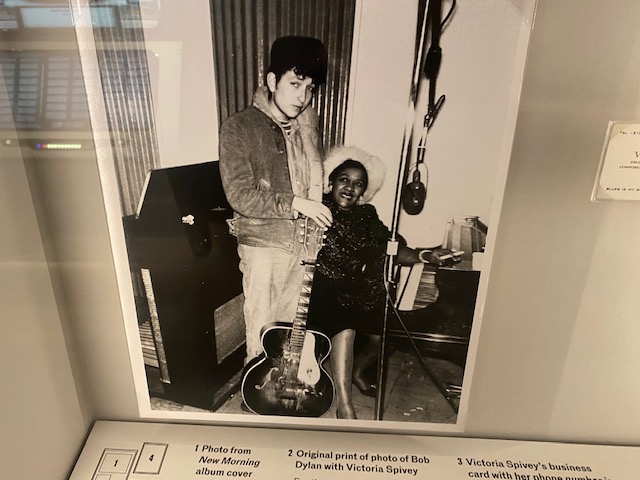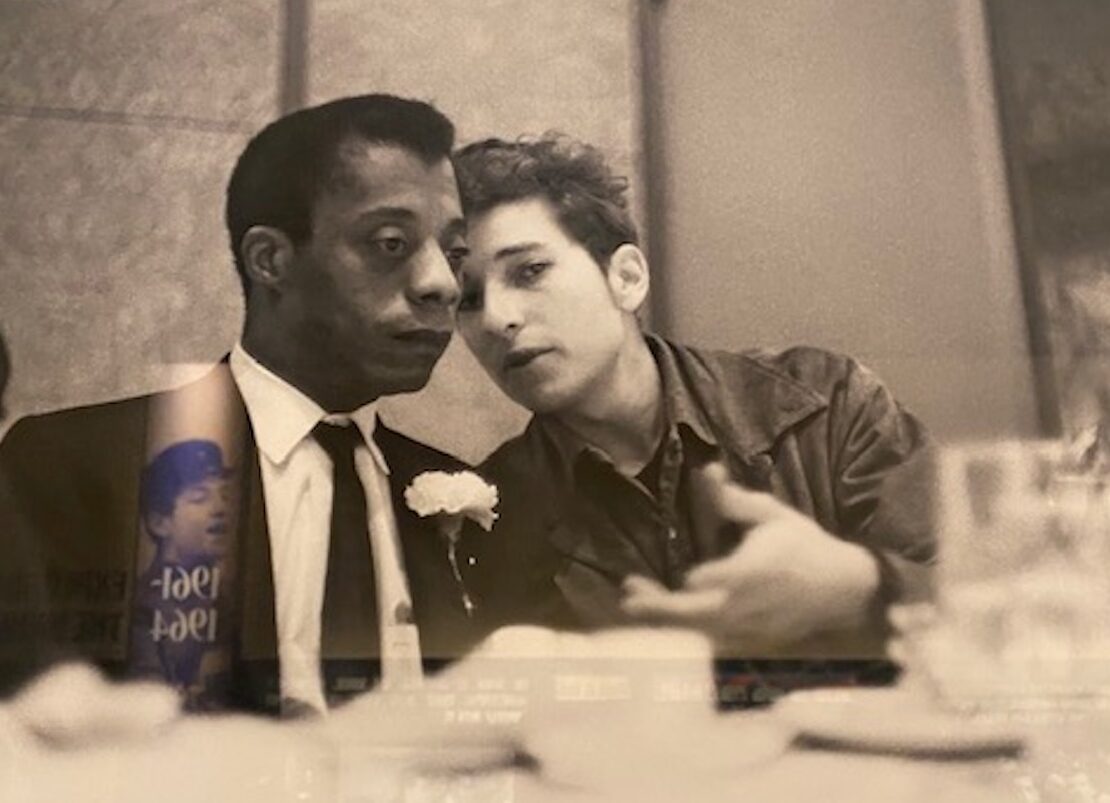By GARY LEE
A tour of the new Bob Dylan Center in Tulsa is a reminder of just how many Bob Dylans there are. Scenes from the wide range of roles the legendary singer/songwriter has played during his six-decade-long career flash across the exhibitions at the sprawling facility. One display about Dylan’s famous “Tangled Up in Blue” album offers a close-up on Dylan the songwriter. It shows how engaged he is in writing and rewriting his lyrics. Despondent over the decline of his first marriage, he wrote at least a dozen versions of the songs on the Tangled album before it was recorded.
Another exhibit features a whole different side of Dylan. Dolled up in black tie, holding a glass of liquor in one hand and a book in another, he’s promoting Heaven’s Door, a whiskey brand he helped found.
But in the Center’s all-encompassing depiction of the life of one of America’s greatest living performance artists, one role Dylan has played stands out for this critic and fan: advocate and lyricist for the American civil rights movement.
Dylan’s interest in the causes of the struggles for justice facing Blacks and others came early. One exhibition at the Center shows a video of the crowd at the 1963 March on Washington. It captures the mood of cultural and political tumult of that era and eventually keys in on a 23-year-old baby-faced Dylan as part of the crowd.

Trust and Legitimacy
Following an introduction by Ossie Davis, the Black actor, Dylan came out and sang ‘Only A Pawn in Their Game.” The song is about the 1963 assassination of civil rights leader Medgar Evers in Mississippi. Dylan’s lyrics attribute blame for the killing and other racial violence to the rich white politicians and authorities who manipulated poor whites into directing their anger and hatred at Black people.
Dylan’s legacy as a raspy but nonetheless fervent voice for American civil rights makes the placement of the Center even more poignant. It is located a few short blocks from Tulsa’s Greenwood District, the scene of a bloody Tulsa Race Massacre in which a white mob destroyed the thriving enclave of Black Wall Street and killed at least 300 Blacks.
After years of planning, the Center opened earlier this month and has already attracted international attention. A pre-opening ceremony showcased appearances by performers Patti Smith, Mavis Staples, and Elvis Costello. The New York Times, The Washington Post and other national news outlets have already lauded the Center in profiles. And a pilgrimage of Dylan fans from as far-off as France and England have already visited the museum, according to the staff.
Blowin’ In The Wind
Although still a relative unknown at the time of his appearance at the March on Washington, Dylan had already come out with the song that would eventually become his most significant hit: “Blowing’ in the Wind.”
An audio narration of Dylan’s life and some recordings of his music, which is given to visitors of the Center, summaries the background to the song. It turns out that the young singer took the tune from “No More Auction Block,” an anti-slavery spiritual. One can hear the words “How many years can some people exist Before they’re allowed to be free?” and relate them to the civil rights movement and the recent Freedom Rides. “How many times can a man turn his head pretending he just doesn’t see?” could refer to the nation’s unwillingness to face its racism or other forms of ignorance.
Before “Blowin in the Wind,” Dylan wrote “The Ballad of Emmett Till,” about a fourteen-year-old African American who was beaten and shot to death in Mississippi in 1955 for whistling at a white woman. It was Dylan’s first “protest” song. In the same period, he also penned “Oxford Town” a song about the riots when James Meredith became the first Black student admitted to the University of Mississippi and “Paths of Victory,” about the civil rights marches.

Hurricane Carter Protests And More
“The Lonesome Death of Hattie Carroll” is a song Dylan wrote, recorded in 1963 and included on his 1964 album The Times They Are a-changin’. The lyrics give an account of the murder of a 51-year-old Black barmaid, Hattie Carroll in 1963 by 24-year-old William Devereux “Billy” Zantzinger. A young man from a wealthy white tobacco farming family in Charles Country, Maryland, Zantzinger was subsequently convicted of assault and sentenced to six months in a county jail.
Another display in the Center discussed the song Hurricane, which Dylan co-wrote with Jacques Levy. It’s about the imprisonment of boxer Rubin “Hurricane” Carter. The song describes acts of racism and profiling against Carter and attributes these acts as leading to a false trial and conviction.
Carter and a man named John Artis had been charged with a triple murder t the Lafayette Grill in 1966. The following year Carter and Artis were found guilty of the murders. The prosecution was widely reported as racially motivated. In the years that followed, controversy emerged over the case, ranging from allegations of faulty evidence and questionable eyewitness testimony to an unfair trial.
In his autobiography, Carter maintained his innocence. After reading it, Dylan visited Carter in Rahway State Prison in New Jersey and later wrote the song. The song helped bring national attention to the case. In 1985, a judge overturned Carter’s conviction.
Harjo Praises Dylan
Joy Harjo, the Tulsa-born Native American poet, makes the case that voices like Dylan’s are needed now as much as ever. “At this moment in history, we are witness to unprecedented and illegal moves to destroy democracy to erase equality and undermine human rights based on false premises of sexism, racism, culturalism for greed,” she said at the opening ceremony of the center.
“In these tangled times, we need the words of the poet, the singers, the prophets, to move in the direction of vision and truth,” Harjo added. She added that one of her poems drew inspiration from Dylan’s song, “Tangled Up in Blue.” Harjo is the first writer in residence at the Center.
Photographs and displays throughout the Center show just how many high-profile figures of the Civil Rights Movement Dylan rubbed shoulders with. In one photo, he is seated next to a young James Baldwin after receiving the Tom Paine award from the Emergency Civil Liberties Union in December 1963. In another, he appears with Coretta Scott King in 1970 at Princeton, where they both received Honorary Degrees.
One of the most eye-catching exhibitions captures a moving scene with Barack Obama and Dylan. It was taken in 2012 when President Obama awarded Dylan the Presidential Medal of Freedom. “There is not a bigger giant in the history of American music,” Obama said.
It would come as no surprise to Dylan fans that one of his early influences was Oklahoma-born protest singer Woodie Guthrie. A display at the Center tells the story of how as a teenager, Dylan visited Guthrie in a hospital in New York. It’s poignant and fitting that the Center devoted to Dylan’s life is next door to the Woodie Guthrie Center.
For students of civil rights, seeing these close and up-front memories of the role Dylan played in the movement is worth the trip.











